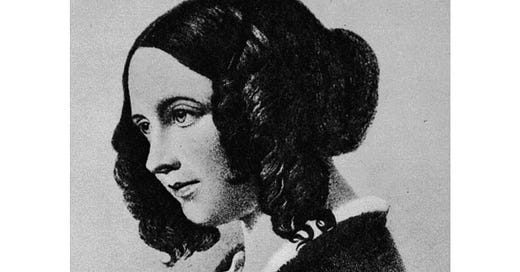Remember that scene in Love Actually where Emma Thompson discovers that the shiny gold necklace was intended for Alan Rickman’s lover and not for her? Remember the heartbreak? The tears? The husky voice of Joni Mitchell providing a soundtrack to that moment of devastation and betrayal?
Now let’s go back in time to May 1858 when a gold bracelet was delivered to the house of one Mr Charles Dickens and placed into the hands of his wife, Catherine: a bracelet that was intended not for Catherine, but rather for the nineteen year old actress, Miss Ellen Ternan, Charles Dickens’ lover.
Ternan had entered the family’s orbit some months earlier when Charles, after seeing the young actress on stage, cast her in an amateur performance of The Frozen Deep he had written. Dickens was 45 at the time. Ellen was 18…the same age as the Dickens’ second daughter.
Rumours had been circulating around London for some time about Dickens’ affairs. He in turn had put word out that Catherine was mentally unstable and a terrible mother.
The bracelet, however, was the last straw. By the end of May 1858, Catherine had moved out of the house. A month later, a separation was agreed whereby Catherine would receive a £600 annual allowance and a carriage. Under British law, the children remained with Charles and were not allowed to see their mother.
Writing about the events surrounding his separation, Charles stated/obfuscated:
Meanwhile, behind the scenes, things were apparently less ‘amicably composed’. A familiar friend would later write:
Fortunately it seems that a doctor - Dr Thomas Harrington Tuke, superintendent of Manor House Asylum in Chiswick - refused to commit Catherine to the asylum.
Their daughter Kate, writing about the time claimed that it was Charles, not Catherine who was unstable:
“My father was like a madman…he did not care what happened to any of us…”
While no correspondence survives giving Catherine’s side of the story, (Charles burned all of her letters) it appears that over the years, Catherine had made some attempts to push back against Charles’ bad behaviour.
Revenge, it appears, was best served up for 2-18 people…
In 1851 a new cookbook appeared on British shelves, entitled What Shall We Have For Dinner? It was written by one Lady Maria Clutterbuck.
The name ‘Lady Maria Clutterbuck’ first appeared in a French farce adapted by Dickens for the family’s 1848 Christmas theatricals. In it, Lady Clutterbuck - played by Catherine in the family production - was a foolish and frumpy widow. Meanwhile in the same production, Charles played the debonair leading man who flirted with the young and attractive leading lady.
When Lady Maria Clutterbuck reappeared on bookshelves, three years later, it was as an astute and creative cook with advice for British women looking for inspiration in order to perk up their kitchens and tables.
Far from being simple hearty food to get one through a standard British meal time, What Shall We Have for Dinner? offered its readers advice on how to cook for 2-18 people and was tailored to reflect seasonality of produce and the practicalities of an ordinary person seeking to craft a multi-course array.
Moreover, the book proved to be a commercial success with five editions published between 1851 and 1860. It seems that Charles was not the only one to enjoy publishing success.
After their separation, Charles toured and published frenetically, rebuilding the career that had been momentarily tarnished by his marital problems. When his will was read following his death in 1870, the first allocation of funds was the gift of £1000 to Ellen Ternan.
By virtue of the Dickens separating rather than divorcing, Catherine was unable to remarry. She lived alone until her death in 1879 at the age of 64.
In the years that followed, historians would bestow upon Charles the moniker of national treasure.
Catherine and her cookbook were largely forgotten.
And what of the actress?
In 1876, Ellen Ternan knocked fourteen years off her age, married a vicar twelve years her junior who knew nothing of her relationship with Charles and together they ran a boarding school for boys.
Ellen lived until the ripe old age of 75. She is buried in Charles’ hometown.





I’m not surprised she didn’t marry again! He was quite the shit, wasn’t he!!
FASCINATING!